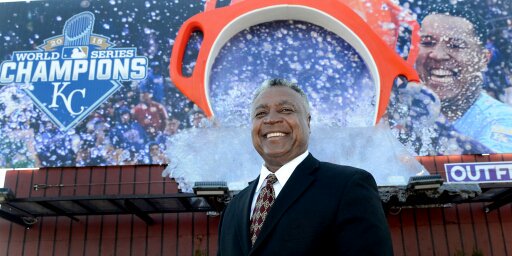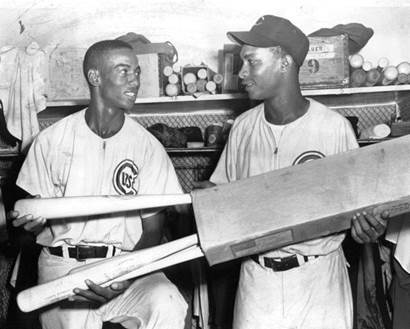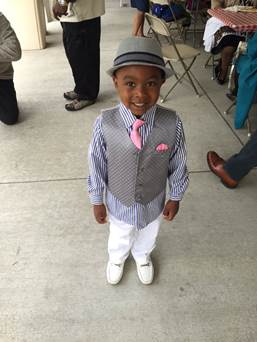In Part One of this second base discussion, we took a look at Hornsby, Collins, Lajoie, Morgan and Robinson as candidates for the best of all-time. Feedback from readers included Gehringer, Sandberg, Alomar, Richardson and Carew. Cardinals fans not only have Hornsby to tout, but also Frankie Frisch, the “Fordham Flash,” and Red Schoendienst. Bobby Grich and Lou Whitaker are in the top 10 of WAR, but not in the Hall of Fame. Nor is Willie Randolph. Bill Mazerowski is in the HOF, but not Frank White who has almost identical numbers, right down to the eight Gold Gloves. Time to talk about Frank.
Frank White – Smooth: Frank White grew up in Kansas City and was a graduate of the Baseball Academy founded by Ewing Kauffman. He played 18 seasons for the Royals, and as any Royals fan over a certain age will testify, Frank’s role was key to the team reaching the post-season seven times from 1976 to 1985. And this was back when only two teams from each league made the post-season. White teamed with shortstop Freddy Patek to give the Royals a top double-play combination on the teams that won three consecutive Western Division titles from 1976 to 1978 – only to be denied the pennant each year by the (Damn) Yankees.
Neither the Yankees nor the Royals won their division in 1979, but they were back for a rematch in the ALCS in 1980. Most people remember the dramatic homer by George Brett against Goose Gossage, but the MVP for that series was Frank White who hit .545. The Royals then lost the World Series to the Phillies. The regular shortstop in that 1980 season was U. L. Washington (another Academy graduate), and he and Frank made up the first black double-play combo in the American League. U. L. (the initials do not stand for anything; that is his name) was known for his trademark toothpick, quite visible both at bat and in the field. [Trivia: U. L. was on base when George Brett hit his big homer off Gossage in the 1980 ALCS and also when George hit the pine-tar homer in 1983].

U.L., toothpick and Frank
In the World Series of 1985, Frank really rose to the occasion. This was back when the DH was used in alternate years in the World Series for all games rather than based on the league of the home team. 1985 was a year without the DH and meant that Hal McCrae would not be in the lineup. Manager Dick Howser inserted Frank in the cleanup spot behind George Brett and made some history – the first time a second baseman batted cleanup in the Series for the AL and only the second time ever – the other being Jackie Robinson. With the Royals down by two games, Frank hit a timely homer in Game 3 to help secure the first Royals victory over St. Louis. He went on to lead the team with six RBI’s as the Royals won their first Series. Howser knew what he was doing.
There are not enough superlatives to describe Frank’s fielding. My favorite one-word description is “Smooth” as he was called by many of his fellow players. Frank won eight Gold Gloves: six straight from 1977 to 1982; then three years for Lou Whitaker; then two for Frank in 1986 and 1987. It should have been at least nine. In 1988, Frank had only four errors, but lost by a vote of 33-31 to Harold Reynolds who had 18 errors. I like this take on Frank by Joe Posnanski:
He was a wonder in the field. Royals Stadium, as it was called then, was covered in artificial turf — perhaps the fastest and bounciest turf in baseball. Balls skimmed off that turf at speeds that made infielders shake. Frank White simply invented a new way to play second base on that turf. He played deep and allowed his strong arm to make up the space. He moved left and right so quickly that he seemed to chase down ground balls from behind. He was probably the best who ever lived at catching pop-ups behind first base….White’s grace, though, was what people would remember most…He had this beautiful, light-footed way of moving, like a dancer, and so when the ball was hit his way there was a jolt of anticipation throughout the stadium. He threw from all angles — overhand, sidearm, underhand, whatever the situation demanded. He contorted his body any number of ways to complete dazzling double plays. No one who saw Frank White play could doubt that they were watching a master.
There are 21 second basemen in the Hall of Fame. Frank and Pittsburg’s Bill Mazerowski are ranked at 54 and 55 in career WAR by Fangraphs. So, it is no surprise that Frank in not in the HOF. But Maz is, and the distinction cannot be gleaned from their stats. Frank had 2006 hits, Maz 2016. Frank had more homers and way more steals. They each won eight Gold Gloves. The reason the Veterans Committee put Maz in the HOF is most assuredly because he hit the walk-off homer that won the 1960 World Series over the Yankees. Timing helps.
Frank is of course in the Royals Hall of Fame, but the best indicator of his value to the first Royals dynasty is that only two players have had their numbers retired: Brett’s #5 and White’s #20. The third retired number is that of manager Dick Howser (#10) who wisely batted Frank at cleanup in the 1985 Series. There is also that cool statue of Frank that stands in the center field fan area and reminds us of his balletic double-play pivot.

Frank White and Yogi Berra: After his playing days, Frank coached for the Red Sox and Royals, managed the Royals AA farm team in Wichita for three years (2004-2006) and then moved to the Royals front office. There was talk that he might become the Royals manager, but the post went to Trey Hillman in 2008. His community relations work for the Royals was supplemented by his joining the Fox Sports broadcast team in 2008. He became very popular in that role, and I very much enjoyed his commentary on the subtleties of the game. In a pay dispute with the Royals, Frank left his front office job in early 2011, and his broadcasting contract with Fox Sports was not renewed after the 2011 season. White was hurt and felt disrespected and vowed he would never again set foot in the stadium. This brings me to Yogi Berra.
Yogi was fired by Yankee owner George Steinbrenner only 16 games into the 1985 season. Yogi vowed to never again set foot in Yankee Stadium. And that is the way it stayed for 14 years. In 1999, after a nudge from Joe DiMaggio, Steinbrenner made the trek to the Yogi Berra Museum in New Jersey and the two made amends. Yankee fans were ecstatic. And the story gets even better.
The Yankees held a “Yogi Berra Day” on July 18, 1999. Don Larsen was there to throw out the first pitch to Yogi catching – a reunion of the battery mates from the only perfect game in World Series history (Game 5 in 1956 against the Brooklyn Dodgers). Yogi’s jumping embrace of Larsen at the end of that game is forever etched in my mind (click here, 26 seconds).
Berra and Larsen then gave way to pitcher David Cone and catcher Joe Girardi (today, the Yankee manager). Cone is a KC native who pitched for Rockhurst High School and in the Ban Johnson League. Cone proceeded to channel Don Larsen and mow down 27 straight Expos, a perfect game. Yogi Berra Day also became David Cone Day. Here is the video of the last out and Girardi’s Yogi-like tackle of Cone (click here, 1 minute).
Now back to Frank. In his 2012 autobiography (One Man’s Dream: My Town, My Team, My Time), the last chapter is only one page and has a simple message: “Never say never.” When Frank parted from the Royals, he had said he would never return to the stadium. By the time he finished his book, he wished he had remembered some advice that manager Tony Muser had given him when Frank was coaching for the Royals: “Never say never. Never say always. What’s most important is to be right at that particular time.”
In September of 2014, a first step was taken. Frank and his wife Teresa attended a game as the guests of Jim Nutter, Jr., and his wife Sonya. Fans around the city were quite happy to see this photo in the KC Star the next morning:

Frank has since been to other games and also returned on September 1, 2015, to be honored as one of the “Franchise Four” of the Royals. This was an MLB promotion for each team, and the Kansas City fans picked White, Brett, Quisenberry and Saberhagen as the Royals best. Frank said he was glad to have stadium grass under his feet again. However, a full reconciliation remains elusive. Frank has moved on and is now serving the community as Jackson County Executive. [Full disclosure – our law firm does some legal work for the county]. He is as popular in politics as he was with the fans – he drew no opponent for either the primary or general election in 2016, and so will be continuing as County Executive for some time. In a rather unique twist, he now runs the county that owns the stadium complex where the Royals play. He also coaches for the KC T-Bones. So what’s next?
My baseball fantasy Part 1: With Frank having opened the door by returning to the stadium, I am hoping the Royals come up with a Steinbrenner solution that brings smiles to the club, Frank and the fans – and much sooner than the 14 years that it took for Yogi. Or as Frank’s agent Steve Fehr was quoted in a 2012 USA Today article: “Eventually, there will be a reconciliation. Frank is too important to the community and the history of the franchise. It would be nice if it happened when everyone is still alive.”
My baseball fantasy Part 2: The Royals win another pennant and County Executive Frank White throws out the first pitch at the K in the World Series. After the game, which the Royals win, Salvy grabs the Gatorade and heads over to the stands and douses White, County Executive suit and all. I already have the photo:

KC Second Base Nostalgia and Trivia: If you have not yet had enough talk about second base, here are some highlights from KC teams.
Kansas City Blues and Monarchs: In 1939, two very good fielding second basemen were playing in Kansas City. The Monarchs featured Newt Allen who is widely considered to be the best fielder at 2B in Negro League history. The Blues, a Yankee farm team, had the Keystone combo of Gerry Priddy at 2B and Phil Rizzuto at SS. In 1941, Priddy and Rizzuto moved up to be the starting middle infielders for the Yankees. Hall of Famer Joe Gordon moved from 2B to 1B to make room for Priddy. But Priddy’s lack of hitting put him on the bench and then to other teams for some good seasons, but never reaching the heights of his old teammate Rizzuto. In 1945, Jackie Robinson was with the Monarchs, but he played SS there before moving on to become a Hall of Famer playing mostly at 2B. In 1950, the notorious Billy Martin played 2nd for the Blues.
Kansas City also has a connection to the first black double-play combo in the majors. Ernie Banks was playing for the Kansas City Monarchs when his contract was purchased by the Chicago Cubs in September of 1953. The Cubs also called up Gene Baker from their top farm club, and these two would be the first blacks to play for the Cubs. They were both shortstops, but Baker moved over the second to set up the historic double-play combo. Baker later became the second black coach in the majors (the first being Buck O’Neil with the Cubs).

Ernie Banks and Gene Baker
Last Sunday, the Royals wore Monarchs’ uniforms and held their annual “Dress to the Nines” tribute to the Negro Leagues. My favorite in the crowd:

Actually, I have two favorites. This darling young lady is the granddaughter of Bob Kendrick, President of the Negro Leagues Baseball Museum:

While I am on the subject of the NLBM, I saw that several members of the Atlanta Braves and Boston Red Sox visited the museum while they were in town this past week. The Boston Herald followed up with an article that ends with an excellent slogan for the museum: “You have to go there to know.”
Kansas City Athletics: The A’s were in KC from 1955 to 1967, and old-timers will likely remember these names in the lineup at 2B: Pete Suder (on opening day, 1955), Jim Finigan, Jerry Lumpe and Dick Green.
Kansas City Royals: Jerry Adair manned 2B for the Royals in inaugural year 1969, followed by the popular Cookie Rojas from 1970 to 1975. For the next 15 years, 1976 to 1990, Frank White owned second base. In the 25 seasons that followed, 14 different players played the most games at 2B in a season (see how many first names you remember): Shumpert, Miller, Lind, Lockhart, Offerman, Febles, Releford, Graffanino, Gotay, Grudzielancek (won a Gold Glove), Callespo, Aviles, Getz and Infante. Ben Zobrist gave us a great partial season in 2015.
[Rojas Trivia: Cookie’s path to the Royals was a part of some important baseball history. He was with the Phillies when he was traded with Dick Allen after the 1969 season to the Cardinals for Curt Flood, Tim McCarver and two other players. The Cards soon dealt Rojas to the Royals who wanted a veteran presence for their young expansion team. The Phillies/Cards trade became famous when Flood refused to report to the Phillies. He instead filed suit against baseball, and although he did not win, he opened the door to a line of legal cases that led to player free agency]
[Toothpick Trivia: U.L. Washington is not the most famous player to regularly chew wood on the field. That would be “Toothpick Sam” Jones who pitched with a toothpick in his mouth. Jones was a product of the Negro Leagues and got in some good years in the majors in the 50’s and 60’s. He led the NL in strikeouts three times and, while with the Cubs in 1955, became the first African-American pitcher to record a no-hitter in the majors.]
Go Royals!
Go Frank White!
